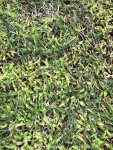Hello,
I’m new to lawns and backyard gardening overall and would like some advice on what type of lawn I have growing (that’s if it is a lawn). It seems as though it’s very fibrous and grows thick and spreads. I’m hoping I can let it cover my backyard and mow it I need some help identifying the name of grass.



I’m new to lawns and backyard gardening overall and would like some advice on what type of lawn I have growing (that’s if it is a lawn). It seems as though it’s very fibrous and grows thick and spreads. I’m hoping I can let it cover my backyard and mow it I need some help identifying the name of grass.



